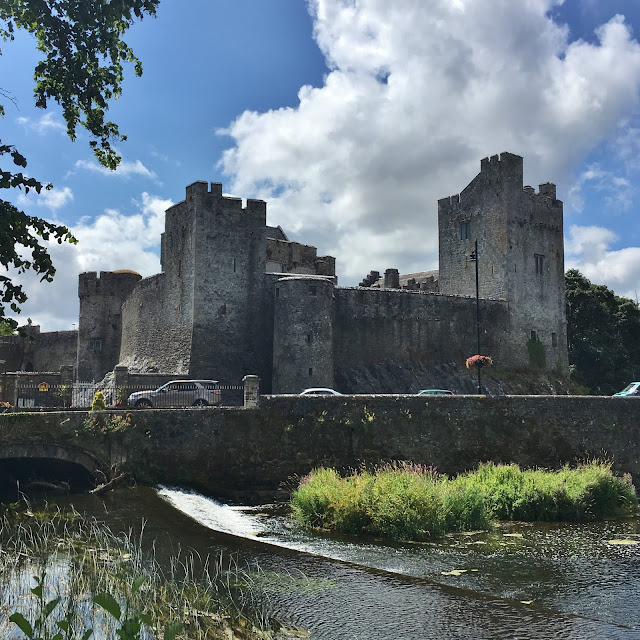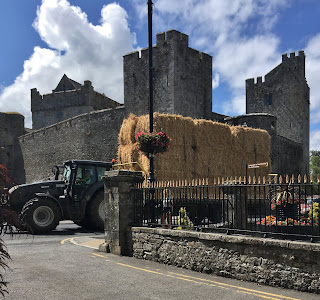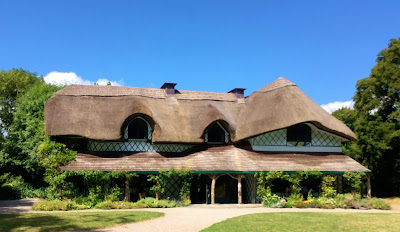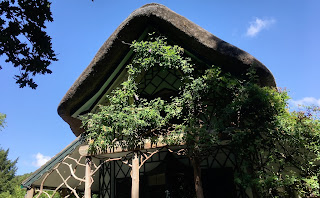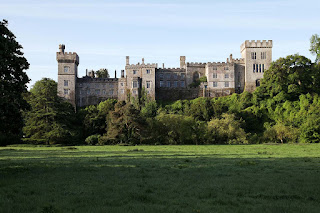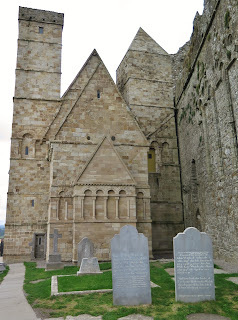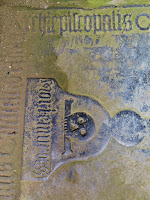The smell of salt air on the breeze, the cry of gulls from above and the tolling of Cathedral bells announcing the hour... We are on Ireland's South Coast, in County Cork starting out our Wild Atlantic Way tour in the harbour town of Cobh!
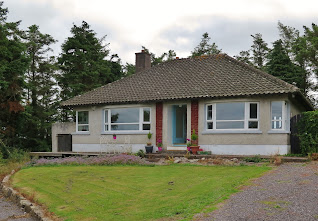 |
| Our Airbnb Near Cobh |
Crossing from County Tipperary into County Cork the landscape had changed entirely once again. The heather-laden Knockmealdown mountains gave way once more to softly rolling hills covered in pasture lands leading down to the sea near Cobh. The coastline was so confusing, there were so many inlets, lakes, rivers, islands and harbours it was hard to tell what was part of the mainland and what was an island.
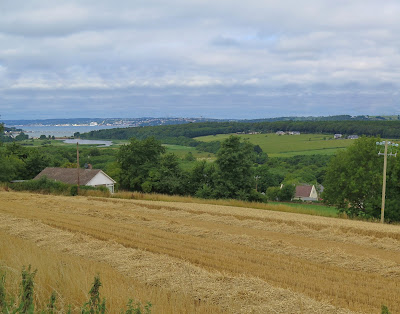 |
| Watching The Cruise Ships In Cork Harbour |
The summer light was still intense well into the late evening, a bonus of Ireland being so far North. After sunning ourselves on the deck of our Airbnb cottage and watching the cruise ships come and go into Cork harbour, we decided to drive the 20 minutes into Cobh (via Midleton) and check it out. Cobh is pronounced "cove" and actually was briefly renamed Queenstown from 1849 to 1922 after Queen Victoria visited Ireland.
Cobh sits on the south shore of Great Island in Cork Harbour. The town is dominated by its beautiful Gothic cathedral perched regally on a cliff high above the harbour. St. Colman's; with its tall spire reaching up to the sky. This is one of the tallest buildings in Ireland and one of the biggest spires in all of Europe. Forty-nine bells are housed within that steeple, and when St. Colman's chimed the hour, it was like listening to a symphony! Walking past the Cathedral, there was a footpath that winds down some steep steps leading down to Cobh's historic waterfront.
Now be ready, Cobh is all things Titanic. The last stop of the RMS Titanic was here in Queenstown (Cobh) to pick up 123 passengers before crossing the Atlantic on April 11, 1912. Or at least, she tried to. There is a wonderful virtual museum called the Titanic Experience that is housed in the actual former White Star Cruise Ship Line ticket office on Cobh's waterfront. The pilings in the water in front of the ticket office are the remnants of the pier where the Titanic was once docked just over 100 years ago-chilling. A €9.50, half-hour guided tour lets you experience what those passengers getting on the Titanic at Cobh experienced the night she went down. I must admit I loved the James Cameron movie Titanic and must have watched it 100 times. It was quite a stirring feeling standing on Cobh's waterfront and staring out into Cork Harbour knowing what was to befall all those people aboard that doomed ship. You can purchase your tickets for The Titanic Experience online at the above link.
There is a stirring memorial on Cobh's waterfront to another doomed cruise ship; the RMS Lusitania that was sunk by a German U-Boat in 1915, three years after the Titanic sank. Cobh's harbour actually has a long busy history of transatlantic voyages dating back for hundreds of years. Almost half of the 6 million Irish who immigrated to North America departed from the port of Cobh as well as the mass deportations of men, women and children bound for the penal colonies like Australia & Tasmania. Today, Cobh is Irelands only dedicated cruise ship terminal, and it sees plenty of tourist action!
Stroll the waterfront of Cobh and enjoy the pretty pub-lined street; picturesque as it is historic. We passed so many seafood restaurants, cafes, bistros and traditional Irish pubs we were spoiled for choice when it came to dinner, but some fresh fish and chips were what we were after that night.
Sitting in a waterfront restaurant enjoying our fish & chip dinner complete with the traditional (and delicious) side of mushy peas. We watched the last of the daylight slip slowly away into the night and the last of the cruise ships departing from the waterfront. I couldn't help but feel a chill run down my spine thinking about the infamous Titanic leaving from this very port 100 years ago; St. Colman's steeple being the last church the passengers ever saw.
Nearby in the town of Midleton, there is a foodie mecca awaiting to be discovered. This pretty little Market town is also home to the Old Midleton Distillery; producer of Jameson's Whiskey. The distillery was in production here for 150 years before a new distillery complex was built next to the existing building in 1975, producing 24 million bottles of Jameson, Powers and Paddy whiskies every year. The old distillery building has been restored to its former glory and offers visitors a short film, a 45 minute guided tour and teaches the story of Irish Whiskey making. The tour ends up in the tasting room where you have a glass of delicious Irish Whiskey and compares Irish Whiskey to Scotch Whisky (so much more than the spelling). The tour is €16 (cheaper if booked online) daily in the summer from 10:00-4:430, and it is my vote for the best whiskey tour in Ireland. www.jamesonwhiskey.com.
A great day trip from Cobh is the little seaside tourist town of Ardmore about an hour away towards Waterford along the N25. Ardmore (Ard Mór or Aird Mórh meaning "great height" in Irish) is a sweet little resort town with the most fantastic swimming beach. For the history buff, Ardmore is a must, with a beautiful ruined Church and a completely intact gorgeous round tower. The Abbey is the oldest Christian settlement in Ireland because of Saint Declan who arrived here and built an ecclesiastical hermitage in 416 a good 15 years before St. Patrick set foot in Ireland. The round tower up on the hill overlooking Ardmore is one of the finest in all of Ireland with three distinct outer rings which is most unusual. The surrounding graveyard is so serene; its Celtic crosses overlooking the Irish Sea. The ruined Cathedral has many early Christian carvings on its west facade, and inside the Cathedral there are two fantastic Ogham Stones. Ogham is an Early Medieval alphabet consisting of lines used to write the Old Irish language. Most of the Ogham stones that survive today are located in Southern Ireland.
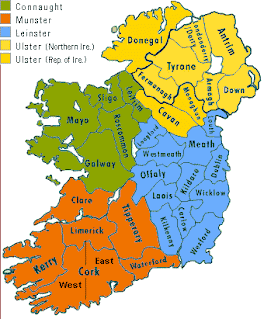 There is also a lovely scenic stroll around the cliffs of Ardmore that is a gentle, one-hour walk. Park at the beautiful Cliff House Hotel and follow the path along the cliffs for stunning coastal scenery (it eventually heads inland and back into town).
There is also a lovely scenic stroll around the cliffs of Ardmore that is a gentle, one-hour walk. Park at the beautiful Cliff House Hotel and follow the path along the cliffs for stunning coastal scenery (it eventually heads inland and back into town).
The South Coast of Ireland has so many charming towns to discover you could spend weeks just rambling from village to village. We were so taken with Cobh, we didn't even get the chance to visit Kinsale with its impressive star-shaped fort overlooking the waterfront. This broke my heart a little because I was looking forward to seeing Kinsale, but it makes me realize I will have to come to Ireland again to see all that I missed on my first visit.
Even though Cobh is a busy tourist port of call for cruise ships that pull into the harbour daily in the summer, most passengers don't stay to explore amicable little Cobh or the other small towns of the South Coast. The tourist crowds go straight on excursions to Killarney National Park or to slobber on that old Blarney Stone, leaving Cobh, Middleton, Ardmore and Kinsale a peaceful delight to discover. I hope you have the chance to explore all that Southern Ireland has to offer too!
Have you discovered any favourite little Irish villages? Let me know in the comments below❣
Cobh sits on the south shore of Great Island in Cork Harbour. The town is dominated by its beautiful Gothic cathedral perched regally on a cliff high above the harbour. St. Colman's; with its tall spire reaching up to the sky. This is one of the tallest buildings in Ireland and one of the biggest spires in all of Europe. Forty-nine bells are housed within that steeple, and when St. Colman's chimed the hour, it was like listening to a symphony! Walking past the Cathedral, there was a footpath that winds down some steep steps leading down to Cobh's historic waterfront.
 |
| Cork Cathedral |
Now be ready, Cobh is all things Titanic. The last stop of the RMS Titanic was here in Queenstown (Cobh) to pick up 123 passengers before crossing the Atlantic on April 11, 1912. Or at least, she tried to. There is a wonderful virtual museum called the Titanic Experience that is housed in the actual former White Star Cruise Ship Line ticket office on Cobh's waterfront. The pilings in the water in front of the ticket office are the remnants of the pier where the Titanic was once docked just over 100 years ago-chilling. A €9.50, half-hour guided tour lets you experience what those passengers getting on the Titanic at Cobh experienced the night she went down. I must admit I loved the James Cameron movie Titanic and must have watched it 100 times. It was quite a stirring feeling standing on Cobh's waterfront and staring out into Cork Harbour knowing what was to befall all those people aboard that doomed ship. You can purchase your tickets for The Titanic Experience online at the above link.
 |
| Lusitania Memorial |
There is a stirring memorial on Cobh's waterfront to another doomed cruise ship; the RMS Lusitania that was sunk by a German U-Boat in 1915, three years after the Titanic sank. Cobh's harbour actually has a long busy history of transatlantic voyages dating back for hundreds of years. Almost half of the 6 million Irish who immigrated to North America departed from the port of Cobh as well as the mass deportations of men, women and children bound for the penal colonies like Australia & Tasmania. Today, Cobh is Irelands only dedicated cruise ship terminal, and it sees plenty of tourist action!
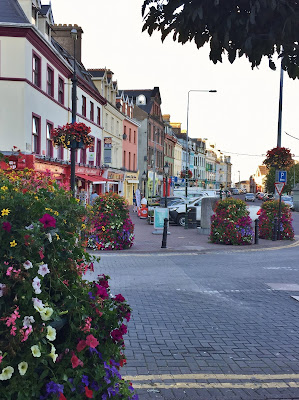 |
| Cobh's Pub Lines Street |
Stroll the waterfront of Cobh and enjoy the pretty pub-lined street; picturesque as it is historic. We passed so many seafood restaurants, cafes, bistros and traditional Irish pubs we were spoiled for choice when it came to dinner, but some fresh fish and chips were what we were after that night.
Sitting in a waterfront restaurant enjoying our fish & chip dinner complete with the traditional (and delicious) side of mushy peas. We watched the last of the daylight slip slowly away into the night and the last of the cruise ships departing from the waterfront. I couldn't help but feel a chill run down my spine thinking about the infamous Titanic leaving from this very port 100 years ago; St. Colman's steeple being the last church the passengers ever saw.
 |
| Old Midleton Distillery |
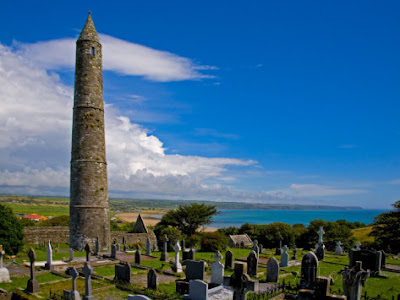 |
| Ardmore's Round Tower |
 There is also a lovely scenic stroll around the cliffs of Ardmore that is a gentle, one-hour walk. Park at the beautiful Cliff House Hotel and follow the path along the cliffs for stunning coastal scenery (it eventually heads inland and back into town).
There is also a lovely scenic stroll around the cliffs of Ardmore that is a gentle, one-hour walk. Park at the beautiful Cliff House Hotel and follow the path along the cliffs for stunning coastal scenery (it eventually heads inland and back into town).The South Coast of Ireland has so many charming towns to discover you could spend weeks just rambling from village to village. We were so taken with Cobh, we didn't even get the chance to visit Kinsale with its impressive star-shaped fort overlooking the waterfront. This broke my heart a little because I was looking forward to seeing Kinsale, but it makes me realize I will have to come to Ireland again to see all that I missed on my first visit.
Even though Cobh is a busy tourist port of call for cruise ships that pull into the harbour daily in the summer, most passengers don't stay to explore amicable little Cobh or the other small towns of the South Coast. The tourist crowds go straight on excursions to Killarney National Park or to slobber on that old Blarney Stone, leaving Cobh, Middleton, Ardmore and Kinsale a peaceful delight to discover. I hope you have the chance to explore all that Southern Ireland has to offer too!
Have you discovered any favourite little Irish villages? Let me know in the comments below❣
Follow me on FACEBOOK, INSTAGRAM and BLOGLOVIN' for daily photos and updates! #slowtravel🐌 #dulgomall


